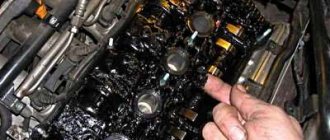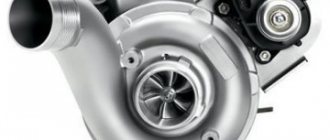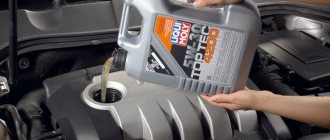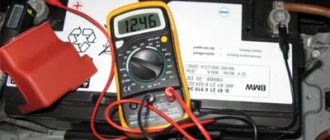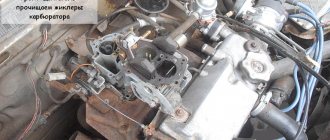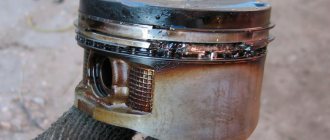Many car owners sooner or later experience a significant increase in oil consumption. They say this - the engine burns oil. The reasons for this phenomenon are various. From the article you will learn why oil consumption increases, how to establish the reasons and not bring the matter to capital (overhaul of the engine).
Where does the oil disappear in a working engine?
A car with a working engine (new or after capitalization) eats oil in small quantities - 20-40 grams per thousand kilometers. When the car operates in difficult conditions (frequent acceleration or driving uphill, driving at an altitude of over 2 thousand meters), then engine oil consumption increases to 100-200 grams per 1000 kilometers. If the engine consumes oil in glasses and liters, it means that something is definitely wrong with it. The main reason for oil consumption: evaporation due to high temperature.
Violation of the ignition timing or fuel injection (diesel engines), as well as changes in the composition of the air-fuel mixture lead to an increase in temperature in the combustion chambers, detonation and other negative consequences. All this affects oil consumption and can lead to the need for major repairs or capital investments.
Why does oil consumption increase?
To understand why the engine began to eat oil, you need to understand what factors lead to excess consumption of lubricant and how they affect the condition of the engine. Oil consumption increases:
Crankshaft oil seal leak
- motor overheating;
- use of inappropriate oil viscosity;
- wear of valve stem seals and rings;
- malfunction of the valve or channels of the crankcase ventilation system;
- poor tightening, drying out, cracking or wear of gaskets, seals and cuffs;
- breakdown or burnout of the cylinder head gasket (cylinder head).
Consequences of engine overheating
Overheating of the engine leads to damage to the oil seals and the appearance of scoring on the cylinder walls. If the overheating was minor and short-lived (the coolant did not boil), then in most cases the motor tolerates 1-2 such overheatings without consequences. After mild but frequent overheating, the caps compress the valve worse and some of the oil gets into the intake manifold. If the engine boils, it is necessary to drive the car away for repairs, otherwise capital damage cannot be avoided.
Using oil of inappropriate viscosity
Caps, seals and cuffs also deteriorate due to the addition of incorrectly selected additives to the oil. Why this happens, read the article “Engine oil additives.” Engines developed in the 60-80s of the twentieth century are designed to work with viscous mineral oil, so the use of liquid synthetics will lead to leaks. In addition, an engine designed for mineral oil smokes if liquid synthetic is poured into it. More modern engines are initially designed for synthetics, so filling with mineral oil will lead to deterioration of lubrication, the appearance of scuffing on the surface of the cylinders and rings, large amounts of oil getting into the combustion chamber and repairs after 50-100 thousand kilometers. The same thing happens if you use the appropriate type of oil, but the wrong viscosity.
How to fix the leakage problem?
In most cases, to eliminate the problem of MM leakage from the motor, it is necessary to dismantle and disassemble the engine.
You don't have to completely disassemble it, but you should remove the head. There is an opinion that when using synthetic motor fluids, there is a high probability of MM consumption due to waste, as well as leakage of material through seals, compared to mineral substances. But this is nothing more than a myth.
We will not talk about engine dismantling and disassembly, since in the case of each individual car these processes are individual. Therefore, if you decide to eliminate the causes of the MM leak with your own hands, then you need to dismantle and disassemble the engine, according to the instructions from the car manufacturer. Only by doing this can you independently eliminate the “leaving” of MM.
What will be needed to fix the leak?
For any repair you will need:
This is what tools are all about. Also, do not forget about the elements that need to be replaced. In each case they will be different.
If the wrong fluid is filled in according to the viscosity class or the oil filter is faulty
This reason is one of the most common. In this case, it is necessary to replace the engine fluid with a suitable one. Also, do not forget that this type of work is not safe to carry out on a hot engine, otherwise the hot oil may burn the skin. Let the engine cool, but not completely cold. Apart from the above tools, you also need to purchase an oil filter that matches your vehicle.
- Place a container for used MM under the drain cap of your motor.
- Unscrew the cap and wait 30-40 minutes until all the liquid has drained out.
- Screw on the drain plug and pour several liters of flushing material into the engine.
- Turn on the engine and let it run for a while. It is better to take a trip to cover at least 30 kilometers.
- Then unscrew the drain plug again and drain the flushing agent from the engine.
- Replace the oil filter with a new one.
- Fill in a new MM that matches the specifications of your motor.
Wear of valve stem seals and rings
If the caps or rings are worn/damaged, oil enters the combustion chamber. The reasons for wear of these parts are described below:
- high mileage;
- engine overheating;
- incorrect oil type or viscosity;
- incorrect selection of additives;
- overspeeding;
- frequent operation of the engine at maximum power;
- cold start.
The repair procedure in this case will consist of replacing the valve stem seals.
Malfunction of the valve or channels of the crankcase ventilation system
Fuel combustion products break through between the piston rings and cylinder walls, increasing the pressure in the crankcase. If the PVC valve is faulty, the pressure becomes too great and pushes through the seals and seals. The leak remains even if the oil is changed. Not everyone who owns a car understands why the health of this system affects oil consumption and does not pay attention to checking it, which must be done during each diagnosis. As a result, the valve fails, after which the channels become clogged with deposits, but the engine does not smoke or lose power.
Poor tightening, drying out, cracking or wear of gaskets, seals and seals
The cause of leaks is a skewed oil seal.
The bolts that secure the engine attachment parts must be tightened periodically. After all, gaskets dry out or shrink over time or under the influence of high temperatures and incorrectly selected additives. The same thing happens with oil seals and cuffs. As a result, oil leaks occur.
Why is this happening?
Conventionally, the reasons for the MM going into the motor can be divided into:
- leaks;
- wear of lubrication system components.
So, let's look at the reasons for MM leakage in more detail:
- Leakage occurs in the rubber seals on the crankshaft and camshaft. If you notice any leaks, the seals need to be replaced.
- Worn out life of the cylinder head gasket. If the engine is dirty, in particular, deposits can be seen on the neck and inside, then it is necessary to change the engine gasket.
- Wear of the oil filter element rubber. This can be determined visually. If the oil filter appears dirty and this can be seen in its housing, then this malfunction may well be the cause of increased consumption of lubricant.
- Failure of oil scraper rings. Usually, when driving a vehicle, gases with a bluish tint come out of the exhaust pipe - also one of the reasons for increased MM consumption.
- Regular overheating of piston rings. This can also be evidenced by the bluish color of the exhaust gases and a fairly low compression.
Checking the engine oil level using the dipstick - Piston failure. Symptoms of malfunction are similar to overheating of the piston rings.
- Failure of the engine cylinders. Here the signs of a malfunction are the same - a bluish tint of exhaust gases and a reduced compression level.
- As stated above - incorrectly selected oil according to viscosity classification.
- The turbocharger bearings have served their service life.
Exhaust color determination
This operation must be done by two people. One press on the gas pedal or the drive/throttle handle/injection pump raises the engine speed to 2-3 thousand. The second one looks to see if the engine is smoking. On diesel engines, when you press the gas pedal sharply, black smoke may appear, which disappears after lowering the engine speed. Gray or bluish smoke, which intensifies as the engine speed increases, indicates that oil has entered the cylinders through caps, rings or a broken gasket, so they need to be replaced. If the exhaust is clear, the caps, rings and gasket are fine.
Finding leaks
A car with severe leaks leaves oil stains on the asphalt and requires urgent repairs. Weak leaks only appear when the engine is running under load, so they leave no traces on the ground. There should be no traces of oil on the surface of a fully functional motor. If you find a greasy wet or damp spot, then there is a leak in that place. To clarify, you need to start the engine and leave it idling to warm up to operating temperature, and then inspect the suspicious area again.
To avoid carbon monoxide poisoning, this must be done outside the garage, in the open air.
If it does not become wet, you need to gradually, within a minute, raise the speed to maximum and carefully observe the suspicious area. If this does not help detect the leak, you will have to drive the car 10-20 kilometers, accelerating sharply from time to time. In this mode, the pressure in the combustion chamber is much higher than usual, therefore the amount of gases breaking into the crankcase is noticeably greater. If after such a check the suspicious place gets more wet, the problem is a malfunction of the crankcase ventilation system and poor tightening or damage to the gasket.
Checking the crankcase ventilation system
To do this, unscrew the fastening clamps and remove the PCV valve, then blow it with lips or a compressor. If it is working properly, then the air will flow only in one direction with little effort. After this, you need to remove and blow out all the hoses, then check the pipes. One of them may be clogged with dirt or sediment.
Top 5 possible causes of oil burns
If you begin to notice that your car begins to consume a large amount of oil, it is very important to understand the possible reasons. In some cases, the reason for this is the banal low quality of the lubricating fluid. If the problem occurs for the first time, try changing the oil to another one. If such measures do not help, perhaps the reasons are as follows:
- Presence of any punctures or cracks. For this reason, the integrity of the crankshaft, camshaft, and balancing shaft seals should be checked. These components are subject to excessive wear and begin to leak oil over time. In addition, this can happen due to improper repairs. Rubber parts are subject to excessive wear due to overheating of the power unit.
- Leaks from various gaskets, such as valve covers, rear oil seals and many others. Such a problem can be caused by natural wear, breakage of bolts due to external influences, or poor quality of their fastening from the very beginning. In this case, the oil flows very slowly, but over time the speed may increase. You can try to tighten them, but the best solution is to completely replace the worn-out unit. The greatest danger is an oil leak from the cylinder head gasket. In this case, you need to count on expensive repairs.
- Need for major repairs. Over time, the engine and its components wear out completely, causing the oil to go to waste. The oil burns in the engine cylinders, forming a protective film. Soon the engine will not be able to operate fully and will have to undergo significant repairs. In most cases, such a problem can be recognized precisely by excessive oil consumption.
- Engine oil entering the cylinders will cause excessive wear on the intake valve stems. This technical fluid flows into the inlet, after which it is sucked into the cylinders - where it finally burns. A certain part of the engine oil remains on the hot walls of the exhaust tract, which significantly complicates the operation of the power unit. In addition, oil may escape through the catalyst into the exhaust pipe, which can be recognized by thick black smoke. The problem can most often be solved by replacing valve seals and valve bushings.
- Excessive wear of cylinder walls, piston rings or other components of the power unit. Due to constant friction, the gap between the cylinder and the piston increases, which significantly increases the size of the oil film on the cylinders. In total, this leads to a loss of expansion force, due to which the piston rings can no longer perform their functions. This also causes coking of the rings, which eventually leads to their failure.
Burnt oil
This is a completely normal engine process. But if the oil burns more, for example, more than 1 liter, then it’s worth thinking about. The main reason for this is poor quality oil. Or when you select an oil with the wrong parameters. Any manufacturer specifies the required parameter for its engine, for example, 10W40, 15W40. So you need to follow exactly these specified parameters. They are indicated in the vehicle's operating instructions. No need to experiment. If your engine is designed for 5W40 engine oil, you do not need to pour 0W20 into it. Many people do this, but it backfires on them. Then the engine burns oil. If you fill in more liquid motor oil, it will simply remain on the walls and burn in the chamber. This is especially true for high-speed engines, where liquid oil actually burns out.
If you pour too thick a lubricant, the film that will form on the walls will be too thick. By the way, this may be the cause of wear on the rings. It will be thick under the ring, the ring will remove it, but it will not pass inside effectively. This will cause the rings to wear out faster. They can also become coked, the walls will wear out, which will lead to increased oil consumption.
Video “Causes of increased MM consumption”
This video describes the reasons for increased lubricant consumption in a vehicle engine.
The engine takes oil, but you don’t understand what’s wrong? We will tell you why the engine eats oil!
There are many circumstances under which an engine can “take” oil; sometimes it is very difficult to find out why the engine “eats” oil at home, and sometimes completely unrealistic. Now I will try to tell you about more possible reasons why the engine may increase engine oil consumption.
Let's dot all the i's right away. What does it mean that the engine is consuming oil or the engine is taking oil? Some people literally understand this driver’s expression, imagining a motor that is powered by motor oil.
